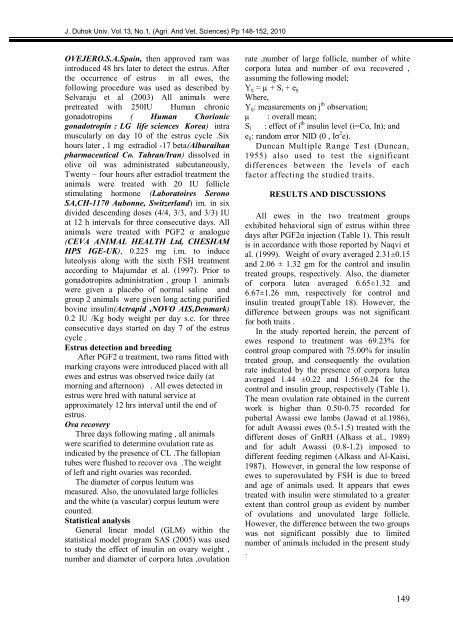The Influence Of Priming Two Cucumber Cultivar Seeds
The Influence Of Priming Two Cucumber Cultivar Seeds
The Influence Of Priming Two Cucumber Cultivar Seeds
You also want an ePaper? Increase the reach of your titles
YUMPU automatically turns print PDFs into web optimized ePapers that Google loves.
J. Duhok Univ. Vol.13, No.1, (Agri. And Vet. Sciences) Pp 148-152, 2010<br />
OVEJERO.S.A.Spain, then approved ram was<br />
introduced 48 hrs later to detect the estrus. After<br />
the occurrence of estrus in all ewes, the<br />
following procedure was used as described by<br />
Selvaraju et al (2003) All animals were<br />
pretreated with 250IU Human chronic<br />
gonadotropins ( Human Chorionic<br />
gonadotropin : LG life sciences Korea) intra<br />
muscularly on day 10 of the estrus cycle .Six<br />
hours later , 1 mg estradiol -17 beta(Alburaihan<br />
pharmaceutical Co. Tahran/Iran) dissolved in<br />
olive oil was administrated subcutaneously,<br />
Twenty – four hours after estradiol treatment the<br />
animals were treated with 20 IU follicle<br />
stimulating hormone (Laboratoires Serono<br />
SA,CH-1170 Aubonne, Switzerland) im. in six<br />
divided descending doses (4/4, 3/3, and 3/3) IU<br />
at 12 h intervals for three consecutive days. All<br />
animals were treated with PGF2 α analogue<br />
(CEVA ANIMAL HEALTH Ltd, CHESHAM<br />
HPS IGE-UK), 0.225 mg i.m. to induce<br />
luteolysis along with the sixth FSH treatment<br />
according to Majumdar et al. (1997). Prior to<br />
gonadotropins administration , group 1 animals<br />
were given a placebo of normal saline and<br />
group 2 animals were given long acting purified<br />
bovine insulin(Actrapid ,NOVO AIS,Denmark)<br />
0.2 IU /Kg body weight per day s.c. for three<br />
consecutive days started on day 7 of the estrus<br />
cycle .<br />
Estrus detection and breeding<br />
After PGF2 α treatment, two rams fitted with<br />
marking crayons were introduced placed with all<br />
ewes and estrus was observed twice daily (at<br />
morning and afternoon) . All ewes detected in<br />
estrus were bred with natural service at<br />
approximately 12 hrs interval until the end of<br />
estrus.<br />
Ova recovery<br />
Three days following mating , all animals<br />
were scarified to determine ovulation rate as<br />
indicated by the presence of CL .<strong>The</strong> fallopian<br />
tubes were flushed to recover ova .<strong>The</strong> weight<br />
of left and right ovaries was recorded.<br />
<strong>The</strong> diameter of corpus leutum was<br />
measured. Also, the unovulated large follicles<br />
and the white (a vascular) corpus leutum were<br />
counted.<br />
Statistical analysis<br />
General linear model (GLM) within the<br />
statistical model program SAS (2005) was used<br />
to study the effect of insulin on ovary weight ,<br />
number and diameter of corpora lutea ,ovulation<br />
rate ,number of large follicle, number of white<br />
corpora lutea and number of ova recovered ,<br />
assuming the following model;<br />
Yij = µ + Si + eij<br />
Where,<br />
Yij: measurements on j th observation;<br />
µ : overall mean;<br />
Si : effect of i th insulin level (i=Co, In); and<br />
eij: random error NID (0 , Iσ 2 e).<br />
Duncan Multiple Range Test (Duncan,<br />
1955) also used to test the significant<br />
differences between the levels of each<br />
factor affecting the studied traits.<br />
RESULTS AND DISCUSSIONS<br />
All ewes in the two treatment groups<br />
exhibited behavioral sign of estrus within three<br />
days after PGF2α injection (Table 1). This result<br />
is in accordance with those reported by Naqvi et<br />
al. (1999). Weight of ovary averaged 2.31±0.15<br />
and 2.06 ± 1.32 gm for the control and insulin<br />
treated groups, respectively. Also, the diameter<br />
of corpora lutea averaged 6.65±1.32 and<br />
6.67±1.26 mm, respectively for control and<br />
insulin treated group(Table 18). However, the<br />
difference between groups was not significant<br />
for both traits .<br />
In the study reported herein, the percent of<br />
ewes respond to treatment was 69.23% for<br />
control group compared with 75.00% for insulin<br />
treated group, and consequently the ovulation<br />
rate indicated by the presence of corpora lutea<br />
averaged 1.44 ±0.22 and 1.56±0.24 for the<br />
control and insulin group, respectively (Table 1).<br />
<strong>The</strong> mean ovulation rate obtained in the current<br />
work is higher than 0.50-0.75 recorded for<br />
pubertal Awassi ewe lambs (Jawad et al.1986),<br />
for adult Awassi ewes (0.5-1.5) treated with the<br />
different doses of GnRH (Alkass et al., 1989)<br />
and for adult Awassi (0.8-1.2) imposed to<br />
different feeding regimen (Alkass and Al-Kaisi,<br />
1987). However, in general the low response of<br />
ewes to superovulated by FSH is due to breed<br />
and age of animals used. It appears that ewes<br />
treated with insulin were stimulated to a greater<br />
extent than control group as evident by number<br />
of ovulations and unovulated large follicle.<br />
However, the difference between the two groups<br />
was not significant possibly due to limited<br />
number of animals included in the present study<br />
.<br />
841



